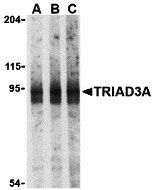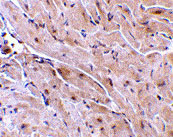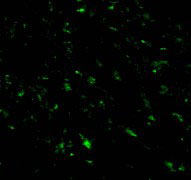TRIAD3A Antibody
- 产品详情
- 实验流程
- 背景知识
Application
| WB, IF, E, IHC-P |
|---|---|
| Primary Accession | Q9NWF9 |
| Other Accession | AAP47174, 31324099 |
| Reactivity | Human, Mouse |
| Host | Rabbit |
| Clonality | Polyclonal |
| Isotype | IgG |
| Calculated MW | 99406 Da |
| Concentration (mg/ml) | 1 mg/mL |
| Conjugate | Unconjugated |
| Application Notes | TRIAD3A antibody can be used for detection of TRIAD3A by Western blot at 0.5 to 2 µg/mL. Antibody can also be used for immunohistochemistry starting at 10 µg/mL. For immunofluorescence start at 20 µg/mL. |
| Gene ID | 54476 |
|---|---|
| Other Names | TRIAD3A Antibody: ZIN, CAHH, U7I1, TRIAD3, UBCE7IP1, ZIN, E3 ubiquitin-protein ligase RNF216, RING finger protein 216, ring finger protein 216 |
| Target/Specificity | RNF216; |
| Reconstitution & Storage | TRIAD3A antibody can be stored at 4℃ for three months and -20℃, stable for up to one year. As with all antibodies care should be taken to avoid repeated freeze thaw cycles. Antibodies should not be exposed to prolonged high temperatures. |
| Precautions | TRIAD3A Antibody is for research use only and not for use in diagnostic or therapeutic procedures. |
| Name | RNF216 |
|---|---|
| Synonyms | TRIAD3, UBCE7IP1, ZIN |
| Function | [Isoform 1]: E3 ubiquitin ligase which accepts ubiquitin from specific E2 ubiquitin-conjugating enzymes, and then transfers it to substrates promoting their ubiquitination (PubMed:34998453). Plays a role in the regulation of antiviral responses by promoting the degradation of TRAF3, TLR4 and TLR9 (PubMed:15107846, PubMed:19893624). In turn, down-regulates NF-kappa-B and IRF3 activation as well as beta interferon production. Also participates in the regulation of autophagy by ubiquitinating BECN1 leading to its degradation and autophagy inhibition (PubMed:25484083). Plays a role in ARC-dependent synaptic plasticity by mediating ARC ubiquitination resulting in its rapid proteasomal degradation (PubMed:24945773). Plays aso an essential role in spermatogenesis and male fertility (By similarity). Mechanistically, regulates meiosis by promoting the degradation of PRKACB through the ubiquitin-mediated lysosome pathway (By similarity). Modulates the gonadotropin-releasing hormone signal pathway by affecting the stability of STAU2 that is required for the microtubule-dependent transport of neuronal RNA from the cell body to the dendrite (By similarity). |
| Cellular Location | Cytoplasm. Cytoplasmic vesicle, clathrin-coated vesicle |
| Tissue Location | Ubiquitous, with the highest levels of expression in testis and peripheral blood leukocytes |
For Research Use Only. Not For Use In Diagnostic Procedures.
Provided below are standard protocols that you may find useful for product applications.
BACKGROUND
TRIAD3A Antibody: Activation of NF-κB as a result of Toll-like receptor (TLR) and IL-1 receptor signaling is a major component of innate immune responses. Signals from these receptors are relayed by a number of adapter molecules such as TRIF, TIRAP, and MyD88. Several regulatory mechanisms exist to control TLR signal transduction, including the inhibition of TLR expression and signaling by molecules such as ST2 and SIGIRR. Another mechanism is by the ubi-quitinization of selected TLRs by TRIAD3A, an E3 ubiquitin-protein ligase. TRIAD3A is a RING finger protein that can bind to TLR4 and TLR9, and to a lesser extent TLR3 and TLR5, catalyzing the ubiquitization of these molecules. Overexpression of TRIAD3A promoted the nearly complete degradation of TLR4 and TLR9; this reduction was reflected in the decreased signal-specific activation by ligands specific for these TLRs. Conversely, depletion of TRIAD3A resulted in enhanced TLR activation.
REFERENCES
Takeda K, Kaisho T, and Akira S. Toll-like receptors. Annu. Rev. Immunol. 2003; 21:335-76.
Vogel SN, Fitzgerald KA, and Fenton MJ. TLRs: differential adapter utilization by toll-like receptors mediates TLR-specific patterns of gene expression. Mol. Interv. 2003; 3:466-77.
Sweet MJ, Leung BP, Kang D, et al. A novel pathway regulating lipopolysaccharide-induced shock by ST2/T1 via inhibition of Toll-like receptor 4 expression. J. Immunol. 2001; 166:6633-9.
Wald D, Qin J, Zhao Z, et al. SIGIRR, a negative regulator of Toll-like receptor-interleukin 1 receptor signaling. Nat. Immunol. 2003; 4:920-7.
终于等到您。ABCEPTA(百远生物)抗体产品。
点击下方“我要评价 ”按钮提交您的反馈信息,您的反馈和评价是我们最宝贵的财富之一,
我们将在1-3个工作日内处理您的反馈信息。
如有疑问,联系:0512-88856768 tech-china@abcepta.com.























 癌症的基本特征包括细胞增殖、血管生成、迁移、凋亡逃避机制和细胞永生等。找到癌症发生过程中这些通路的关键标记物和对应的抗体用于检测至关重要。
癌症的基本特征包括细胞增殖、血管生成、迁移、凋亡逃避机制和细胞永生等。找到癌症发生过程中这些通路的关键标记物和对应的抗体用于检测至关重要。 为您推荐一个泛素化位点预测神器——泛素化分析工具,可以为您的蛋白的泛素化位点作出预测和评分。
为您推荐一个泛素化位点预测神器——泛素化分析工具,可以为您的蛋白的泛素化位点作出预测和评分。 细胞自噬受体图形绘图工具为你的蛋白的细胞受体结合位点作出预测和评分,识别结合到自噬通路中的蛋白是非常重要的,便于让我们理解自噬在正常生理、病理过程中的作用,如发育、细胞分化、神经退化性疾病、压力条件下、感染和癌症。
细胞自噬受体图形绘图工具为你的蛋白的细胞受体结合位点作出预测和评分,识别结合到自噬通路中的蛋白是非常重要的,便于让我们理解自噬在正常生理、病理过程中的作用,如发育、细胞分化、神经退化性疾病、压力条件下、感染和癌症。








